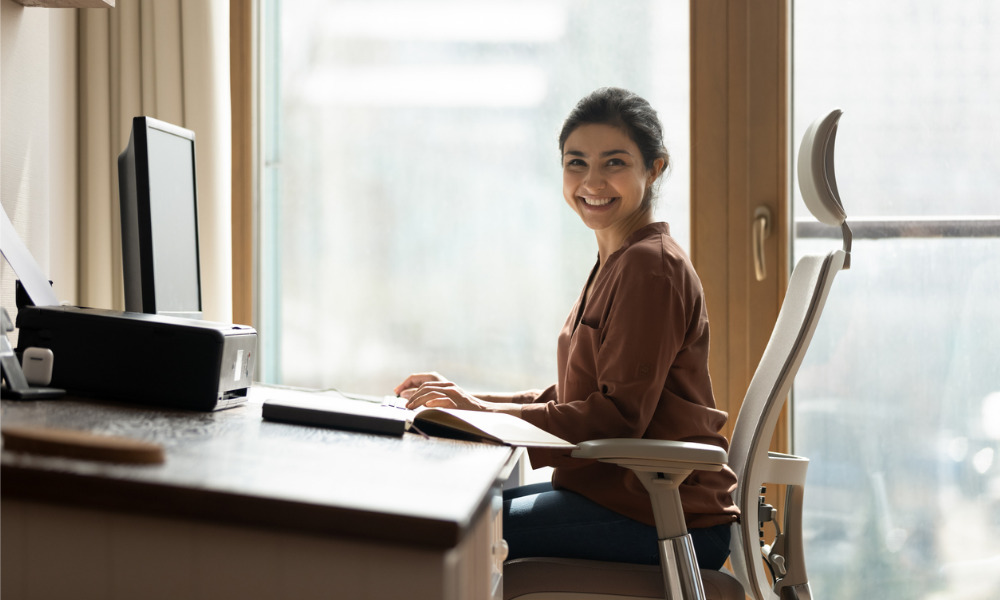All the essentials you need to avoid injury and build an optimal at-home office

Two years into the pandemic, many Canadians are still working from home (or have been on and off since the start of Covid). Despite this, many employees are still toiling away with sub-par equipment: working on kitchen tables, sofas or even in bed.
For those making the move to permanent telework, or who are spending more time working from home, good ergonomics is key – and the crux of good ergonomics is adjustability:
“Whenever I recommend anything, I do tend to look at adjustability – so it can be moved from individual to individual,” says Kathy-Lynn Shaw, CEO, Kinetic Life Solutions, a Canadian Certified Professional Ergonomist (CCPE) and president of the Association of Canadian Ergonomists.
Chairs, sit-stand desks, ergonomic keyboards – here are Shaw’s recommendations on what to look out for.
NB: While Shaw recommends certain products, she is keen to not promote one material or brand over another. Ultimately, Shaw says that users should find what works best for them and “anything having similar features that I’ve outlined here would also work".
1, Laptop riser
Risers are available at set heights and adjustable ones. Using a laptop stand or riser to elevate the laptop from the work surface can help prevent the user from hunching over their laptops and reduce neck strain.
“You can get a lot of different ones on the market, but I usually recommend one that has a little bit more height adjustability,” says Shaw, “because that will cover different ranges of heights that people require to get the laptop screen up to their seated height.”
Shaw recommends the Ergotron Neo-Flex Notebook Life Stand as a good option.
2, Ergonomic keyboard
Shaw says that there is not one model of keyboard that she typically recommends.
Many people enjoy molded split keyboards, she says, but it really varies on the individual.
She says that she typically recommends the Kinesis Freestyle Split keyboard, because the user can determine how far away the keyboard is split (as opposed to molded split keyboards, which are a set size).
A good fit also depends on the person’s size.
“If they’re smaller, I tend to recommend a smaller keyboard,” says Shaw, such as the Contour Balance keyboard.
Shaw also says that, personally, she likes a soft touch keyboard as well as a straight edge on the keyboard in case she has to add a different mouse or other pieces of equipment to her set up.
Read more: Four ways to ensure worker safety during a snowstorm
3, Palm support
Palm supports are meant to rest your wrists when you’re not typing.
“I do recommend palm supports,” says Shaw, “But it depends on the individuals.”
For those who are able to type in a neutral position, they may not be necessary. Unfortunately, says Shaw, many of us are self-taught typists and so may not always know how to position the wrist.
“They should be in a neutral position,” says Shaw. “I recommend palm supports if an individual tends to rest their palms on the desk and there’s too much of an extension in their wrists.”
Shaw recommends a gel support which is a little softer on the palms – and a support that is placed under the palms not the wrists.
4, Ergonomic mouse
“I tend to recommend a roller mouse,” says Shaw. Specifically, the Contour RollerMouse. Particularly for those who are smaller (i.e. if your shoulders are not as broad).
“It places your arms closer to your sides, so you’re not reaching out to the side as much. This is why I usually do tend to recommend a smaller keyboard as well, so that you’re not extending and reaching too far to the side with the mouse.”
For these models there is an adjustment period, says Shaw, but it works well – especially for those who have Carpal Tunnel Syndrome.
She says that Mouse Trapper also makes similar mouses.
5, Foot rest
Shaw typically recommends an adjustable footrest that also moves forwards and backwards.
“It depends on how much the body requires to be supported. If you’re only an inch or two off the ground, you can use a lower footrest. But I’ve been in workplaces where people have been off the ground significantly, so they would need a higher foot rest
A good model, she says, is the Fellows Standard Two Position foot rest.
However, Shaw says: “The most important tip when using a footrest is to make sure it is not too high placing your knees higher than the hips as it will put too much strain on the low back. Knees and hips should be lined up, or even the knees slightly lower than the hips.”
6, Workstation
The newest thing on the market is sit-stand workstations – but not everyone needs one.
“I think they’re great if you’re sitting for a long time at your desk, and if you’re not making a conscious effort to get up,” says Shaw. For those often up and walking around, they are probably not necessary.
For those who need one, “I will usually recommend one that adjusts straight up and down,” says Shaw.
There are some models that extend towards the individual, but Shaw says that she doesn’t recommend these as much because they limit the space around your desk.
Shaw recommends Ergotron desks (such as the Workfit-TX model).
“The other thing you have to be careful with is, sometimes people will have an L-shaped desk with a 90- degree corner and they’ll want to put their computer in the corner. In this case the arms of the chair may limit them for getting close enough to the desk so they’re leaning out of the chair,” she says.
In this case, she recommends a desk with a straight corner instead of a 90- degree angle. For those not able to switch desks, you can get a corner adapter, a piece of equipment which will slide into the corner of the desk and make a straight corner.
7, Monitors
Shaw says that she has noticed that people typically invest in cheap monitors which have no adjustments.
“I recommend a heigh adjustable monitor, and whatever size is comfortable for you,” she says. “If you’re using dual monitors, I do recommend them being the same size because it’s easier for the eyes to adjust.”
8, Ergonomic chair
Again, Shaw says that the key to a comfortable chair is something that is adjustable. For chairs, the three main things to look out for are armrests, seat pan and backrest.
You don’t have to have all the features, she says, but you really need to be able to adjust your seat pan to support your leg length when seated.
“You also want to have a backrest adjustment, so the backrest should move up and down so it fights in the small of your back. It should also angle forward and backwards, separate from the chair itself,” says Shaw.
For those sitting down most of the time, extra lumbar support is good. Shaw says that you can get an additional pump to blow the backrest up to provide more support to the lower back.
For armrests, Shaw says you should be able to adjust them up or down, as well as over the seat pan with a width adjustment or a pivot adjustment. Again, your arms should be resting comfortably by your side and your arm rests should be able to reach in over the seat pan to support this position.
In addition: “A lot of times, people don’t realize there is a counterbalance that’s built into your chair – usually a dial under your seat,” says Shaw. You can tighten it or loosen it to counterbalance your weight.
Shaw recommends Chairs Limited, a company based in Dartmouth, Nova Scotia, as well as ErgoCentric, Global, or Obusforme Chairs.
“I have dealt with Chairs Limited for over 20 years. They build the chairs on-site so if slight adjustments are required to accommodate various sizes of clients, they can make the changes required,” says Shaw.
9, Headset
“In this day and age, a lot of times we’re on Zoom calls or even on our cell phones, and so it always puts the neck in awkward positions,” says Shaw. Headsets “are a very cost-effective way to prevent neck injuries, it just keeps your neck in a neutral position.”
Plantronics makes a variety of headsets. Any headset would work, but you need to make sure they are compatible with your phone.
You can get over-the-ear or over-the-head sets. It is up to the user what they find more comfortable (e.g. some users may get headaches from over-the-head models).
10, Document holder
If you require a document holder (this depends on your daily tasks), Shaw recommends one that will fit between your keyboard and your monitor so that it keeps your neck in a neutral position.
Placing them flat on the desk or off to one side can change your neck position.
“I don’t always recommend a document holder,” says Shaw, but “if people are referencing documents, they should definitely use one.”
Shaw recommends a couple of models, including document holders from 3M as well as a Microdesk which is sturdy enough to write on (e.g. if you need to reference documents and check them off, make notes, etc.).
Recommended ergonomics equipment will vary from person to person and will depend on individual measurements and needs, as well as the tasks they are performing while at their desk. Look for adjustability in equipment and make sure if fits you comfortably. In shared spaces, adjustability will be key in fitting a variety of workers. Shaw also recommends trying items for a couple of weeks to determine fit and effectiveness. The important thing to remember is any item should work to maintain the body in a neutral position.





